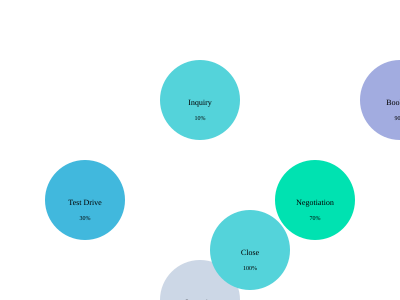When I first joined the automotive sector, predicting sales felt akin to weather forecasting with a blindfold. But then, sitting in a strategy meeting, someone pulled out a graph predicting sales with surprising accuracy. This sparked my curiosity: could Opportunity Stage Sales Forecasting be the secret sauce to effective sales strategy? Embarking on this journey, let's explore how this model metamorphoses mystery into clarity.
Understanding the Sales Cycle: An Automotive Odyssey
The path from the first *spark of interest* in a new car to the moment the keys are handed over is a journey. Ever wondered how it all unfolds step by step? Let's explore the stages of automotive sales that guide potential buyers from first contact to driving off the lot.
Stages of the Automotive Sales Cycle
Inquiry (10%): This is where the magic begins. A customer shows initial interest and might visit a showroom or interact online.
Test Drive (30%): Hands on the wheel, buyer dreams of possibilities. Genuine interest peaks here.
Quotation (50%): A proposal lands. Numbers meet expectations—or not. The wallet weighs in on decisions.
Negotiation (70%): Haggling ensues. Dealers and buyers dance around the table, seeking common ground.
Booking (90%): Almost there! Customers commit with a booking, sealing intentions in writing.
Close (100%): Victory! The deal is finalized. New car, new adventure.
Why Do Long Sales Cycles Matter?
In the automotive world, patience is not just a virtue: it's necessary. A longer sales cycle affects forecasting accuracy, complicating predictions. Why's it such a challenge? Well, understanding each stage of the sales cycle is key to unlocking accurate forecasts. Every stage has its conversion probability, painting a detailed picture for planning future sales.
The Role of Customer Sentiment in Predicting Sales
We all know it: emotions often drive decisions. What's fascinating is how customer sentiment can be a predictor of sales. If positive feelings are swirling around a brand or model, sales might soar. Negative reviews? They could spell doom. What do you think? Does emotion in car-buying echo your experiences too?
Economic Factors Influencing Buyer Behavior
Money talks, right? Economic circumstances, like interest rates and gas prices, heavily influence buyer choices. Fancy models might suffer during downturns, while economy vehicles shine. Recognizing these factors helps us predict when and what people will buy.
Below is a mind map illustrating the stages of the automotive sales cycle with probabilities attached to each stage:

Cracking the Code: The Formula Behind the Forecast
How do we transform potential sales opportunities into accurate sales forecasts? We’ve all pondered over the mystery of sales forecasting at some point. It's like deciphering a complex code, isn't it? Well, let's crack it together. We use weighted opportunity value formula, a powerful tool for understanding and predicting future sales.
Breaking Down the Formula
The formula itself is quite straightforward, but its implications are profound: Sum of opportunity value multiplied by stage probability. What do we mean by this?
Opportunity Values: These reflect the revenue potential at each stage of the sales pipeline. Think of it as the value that's at stake.
Stage Probability: This is where things get interesting. We assign probabilities to different stages of our pipeline. You know, like stages in a play. What are the odds that a prospect moves from interest to purchase? That's your stage probability.
Connecting Values with Potential Revenue
Each opportunity's value isn't just a number; it’s a representation of potential revenue. By multiplying this value with its associated probability, we begin to see how likely it is to realize this potential.
Assigning Probabilities to Pipeline Stages
You might be wondering, "How do we decide on probabilities?" Great question. Here’s where historical data steps in. By examining past behaviors, sales cycles, and outcomes, we assign probabilities reflective of real-world scenarios. As they say—
"A successful forecast model respects the intricacies of probability and value aligning."
This statement sums up the delicate balance we aim to achieve with our forecasting model.
Using Historical Data for Precision
Historical data isn’t just about the past; it’s about improving future precision. It’s like having an old map to navigate new terrains. By understanding past patterns, we can make smarter predictions about what’s next. And, with real-time data flowing in from active sales opportunities, the model is ever-adapting. It grows with us!

Let’s look at an example:
Opportunity | Value ($) | Probability (%) | Weighted Value ($) |
|---|---|---|---|
A | 30,000 | 30 | 9,000 |
B | 45,000 | 70 | 31,500 |
C | 60,000 | 90 | 54,000 |
Total Forecasted Sales | 94,500 | ||
Our forecasted sales in this scenario total $94,500. That’s quite a number, and it’s rooted in understanding the dynamics of probability and value together.
This approach to sales forecasting isn't just theoretical. It’s the same kind of model that industries, like automotive manufacturers, use to anticipate demand. They harness these insights to make strategic decisions, optimizing every aspect—from resources to marketing strategies.So, what's next in our journey of sales forecasting? Stay tuned as we delve deeper into the magic of aligning predictions with reality.
Driving with Data: The Role of Seasonality and Market Conditions
In the automotive industry, predicting sales is like navigating through busy traffic — it requires skill, precision, and an understanding of the environment. At the heart of this process is the need to adjust forecasts for seasonal trends and market conditions.
Adjusting Forecasts for Seasonal Trends
Seasonality plays a major role in automotive sales. It’s no secret that certain times of the year, like holidays or end-of-year events, see a rise in consumer interest. Promotions during these periods can create significant demand spikes, much like a rush hour commute.
Sales typically peak during year-end promotions.
New models released in the fall might attract early adopters.
So, how do we adjust our forecasts? By analyzing historical data to identify when these spikes occur, businesses can anticipate demand and prepare accordingly. After all, "Adapting forecasts to seasonal changes ensures businesses are steering in the right direction."
Impact of New Model Launches on Sales Forecasts
Every new model introduction brings a wave of excitement — comparable to a new blockbuster hitting theaters. Manufacturers must harness this interest, adjusting their forecasts to reflect the potential surge in sales. But what happens when the hype fades? Keeping an eye on test drive schedules and customer inquiries can help maintain and adjust forecasts.
Adapting to Economic Shifts
Economic shifts are perhaps the most unpredictable factor. Just as the trend towards eco-friendliness has driven interest in electric vehicles (EVs), other shifts can influence consumer behavior. For instance, rising fuel prices might suddenly increase demand for hybrid models.
Adapting to these economic shifts is crucial for staying ahead — a bit like changing lanes smoothly to avoid a sudden traffic jam.
Leveraging Data for Strategic Sales Planning
The key to navigating this complex landscape is data. By leveraging historical and real-time data, manufacturers can refine their strategies efficiently. Sales forecasts become refined maps, outlining paths that we can take to reach our destination. Adjust models for patterns like new launches, adjust inventory levels, and shape marketing efforts. In summary, driving with data not only helps manage expectations but maximizes opportunities as well.
Applications in Automotive: Beyond Mere Predictions
In the world of automotive sales, the value of effective forecasting cannot be overstated. Why? Because it helps businesses stay ahead in an industry where market dynamics shift rapidly. Let me share how it works.
1. Optimizing Inventory to Meet Predicted Demand
Inventory management becomes a breeze with demand forecasts. We use data from ongoing sales opportunities to fine-tune stock levels. Imagine not holding onto excess inventory, or worse—running short when demand spikes.
By analyzing factors like customer interest and regional demand, we ensure that the right models are available at just the right moment.
2. Aligning Production Schedules with Sales Forecasts
Aligning manufacturing schedules with predicted sales is critical. By understanding forecast insights, manufacturers can adjust production levels accordingly. This alignment minimizes resource wastage and enhances efficiency, ensuring production capacity matches actual need.
3. Refocusing Sales Strategies Based on Pipeline Analysis
The power of a good pipeline analysis lies in the details. We delve deep into potential bottlenecks within sales stages. With insights, sales teams can adjust strategies. Are potential deals stalling? Pinpointing such bottlenecks allows us to take action, overcoming barriers for smoother sales conversion.
“Effective forecasting empowers adjustments across sales and marketing strategies.”
4. Creating Targeted Marketing Campaigns
Marketing is where creativity meets data-driven strategy. By identifying models with high interest yet low conversion, we tailor campaigns effectively. It's about focusing efforts where they're needed most, turning curiosity into commitment.
Why This Matters
Helps in inventory management
Aids in production planning
Supports strategic marketing initiatives
These practices form the backbone of a responsive automotive business model. Using data and analytics isn't just important—it's transformational.
This breakdown of the section demonstrates how forecasting transcends mere predictions, becoming a valuable tool for strategic decision-making in the automotive industry. From ensuring the right cars are ready for eager buyers to crafting campaigns that captivate interest, it's all about using insights to drive success.
The Road Ahead: Harnessing Predictive Power
Have you ever wondered how companies anticipate future demands with such accuracy? It seems almost magical, doesn’t it? But in reality, it's all about harnessing the power of real-time data and predictive analytics. Imagine you're driving a car not just by looking at the dashboard, but by watching a live street view, knowing every turn before it arrives. That's what real-time data can do for decision-making.
Real-Time Data Integration in Decision Making
When businesses integrate real-time data into their decision-making processes, they see heightened accuracy. It's like having a GPS navigation that updates every second rather than every few minutes. Similarly, by constantly analyzing live data, companies can adjust their strategic course instantly. This integration, friends, is truly a game-changer.
Improving Forecast Accuracy
Now, how do trends fit into this picture? Well, ongoing trend analysis vastly improves forecast accuracy. Businesses that stay attuned to the latest market pulses—rather like surfers gauging the waves—are the ones that ride smoothly through the competitive ocean.
Accentuating Predictive Power for Strategic Advantage
Predictive models don't just predict; they transform. They give teams a strategic leverage by anticipating what lies ahead. As someone once said,
"Predictive power is not just about foresight; it's about insight."
This insight provides a roadmap, ensuring resources align perfectly with customer demands, a clear advantage in any industry.
Aligning Resources with Demand Shifts
An intriguing analogy would be an orchestra tuning its instruments. Just as musicians adjust their pitch based on the conductor's cues, businesses align their resources based on predictive insights. This ability to swiftly respond to demand changes is akin to a synchronized dance—one that propels businesses ahead.
Imagine a company as a racer on a track. Predictive power isn't just the engine; it's the whole pit crew strategizing. They ensure every turn is anticipated, every speed bump gently navigated.

In conclusion, real-time data-driven insights indeed bolster competitive positioning. Embracing the predictive power isn't just about getting ahead—it's about staying there. As we look to the future, leveraging these insights allows businesses to plan more effectively, ensuring that every decision is a step on a clearer path forward. Remember, the road ahead is always smoother with the right insights at your disposal.



